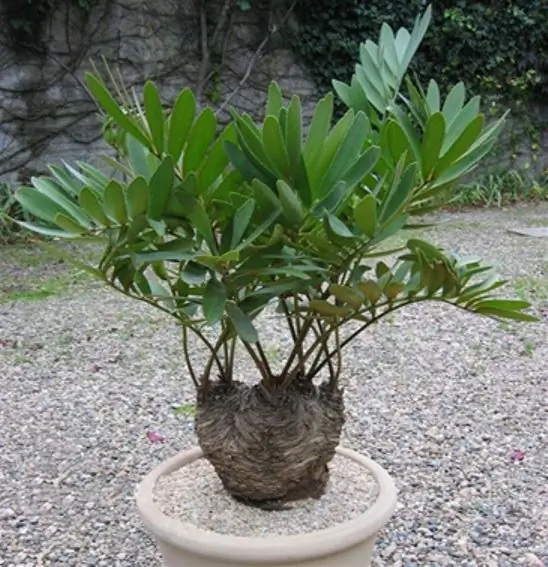Zamia is often confused with a palm tree. In fact, this interesting plant is a relative of the cicas. Zamia appeared more than 200 million years ago, in the Mesozoic era and has survived to this day. Therefore, zamia is called a relict plant.

What does zamia look like
Rough zamia is most often on sale. It is also called the "cardboard palm" throughout the world. The plant reaches a height of 1 m. Part of the trunk is located above the ground and resembles a cone.
When buying, you need to choose a zamie with a large "bump" size. The larger it is, the more leaves it will grow. The few leaves in zamia appear alternately, and not in a fan, like in cicas.
What kind of care does Zamia prefer?
Zamia perfectly tolerates direct sunlight, but in summer it needs to be shaded from the midday sun. In winter, it is advisable to lower the temperature to + 17 ° C, in the rest of the year the usual room temperature is suitable.
You need to water the zamia with soft, settled water. In winter, watering is reduced, but complete drying of the substrate must not be allowed. Zamiya is absolutely undemanding to air humidity.
How to transplant and feed zamiya
Zamia, like cicas, does not tolerate mineral fertilizers. In the spring-summer period, organic fertilizers can be used. In winter, feeding is not required.
A plant transplant is required infrequently - once every 2-3 years. The pot is selected a little more than the previous one. Drainage is laid at the bottom of the tank. The soil mixture is made up of equal parts of humus, sod and leafy soil, peat and sand with the addition of perlite.
The substrate should be nutritious, drained, of medium density.
How Zamia reproduces
Zamia can bloom if given a dormant period in winter and bright enough lighting throughout the year. But since zamia belongs to dioecious plants, two specimens are needed to get seeds, blooming at the same time.
It is quite possible to grow zamia yourself from fresh purchased seeds. In a container with a diameter of not more than 9 cm in peat soil, seeds of zamia are sealed to a depth of not more than 1 cm. The soil mixture is abundantly sprayed and the pot with seeds is kept at a temperature of + 30 ° C. Fresh seeds take 1 to 3 months to germinate. Seedling care is the same as for adult zamia plants.






